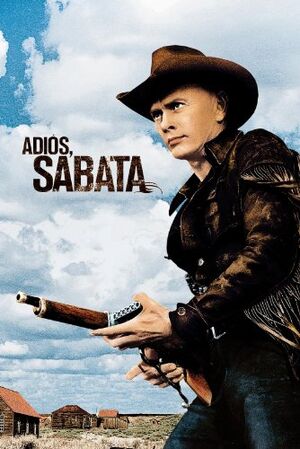Adios, Sabata (Italian: Indio Black, sai che ti dico: Sei un gran figlio di..., lit. Indio Black, you know what I'm going to tell you... You're a big son of a...) is a 1970 Italian-Spanish Spaghetti Western film directed by Gianfranco Parolini. The film stars Yul Brynner as the titular "Sabata" or "Indio Black" in the original film title.
During the time when France intervened in Mexico creating the second Mexican empire at the hands of Maximilian I, a mysterious bandit named Sabata (Originally Indio Black) is hired by the leader of the Mexican guerrilla, Señor Ocaño, to steal a shipment of gold from his property of the Austrian army.
Adios, Sabata is the second part of the so-called Sabata Trilogy, although it was originally an independent film, which was included in this series of films to take advantage of the monumental success that Sabata turned out to be.
The following weapons were used in the film Adios, Sabata:
Pistols
Remington 1866 Derringer
Throughout the film, Ballentine's men are armed with Remington 1866 Derringer as their primary handguns. Considering that the film is based on the era of the Second Mexican Empire (1863-1867), the appearance of Remington 1866 Derringer suggests that the film takes place during the final days of the French intervention in Mexico.

Remington 1866 Derringer w/ polished steel finish and pearl grips - .41 Short Rimfire (RF)

Sabata is threatened by one of Ballantine's men with a Remington 1866 Derringer.

Ballantine's men point their Remington 1866 Derringers at Folgen's living room to blackmail him.

One of Ballantine's men points his Remington 1866 Derringer at Manuel García without him realizing it.

Ballantine's men surround Escudo's revolutionaries at their base, some armed with Remington 1866 derringers.
Sabata's Derringer
As in the previous film in the trilogy, Sabata (Yul Brynner) is armed with his personal Derringer, although unlike Lee Van Cleefs Sabata's Derringer, it is not used much in the film.

When Ballantine and two of his men go to look for Sabata in a small stable, the latter prepares a series of traps beforehand to get rid of them.
A good side shot from Sabata's Derringer.

Sabata fires his Derringer to make a bag of sand fall to activate one of his traps against Ballentine.
Note that unlike the Derringer from the first film, Sabata uses a slightly modified Remington 1866 Derringer with a brass frame and a ring on the barrel.

Sabata points his Derringer at the legs of the chair where Ballentine is sitting, repeating one of the most iconic scenes in the Sabata trilogy.
Revolvers
Colt 1873 Single Action Army
Escudo (Ignazio Spalla) and others secondary characters use a Colt Single Action Army as their primary handgun during mostly of the film, only the 7.5" barrel or "Cavalry" variant. This is an anachronism, as Colt Single Action Army was introduced in 1973 and the film takes place in the mid-1960s.
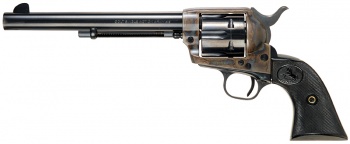
Colt 1873 Single Action Army w/ 7.5" barrel - .45 Long Colt

Escudo points his Colt SAA at one of his revolutionaries, who was behaving like a maniac.

Manuel García (Salvatore Billa) points his Colt SAA presumably at Escudo, who believes that García wants to kill him.

A good frontal shot from the Colt SAA, revealing that Manuel García was aiming for one of Ballantine's men.

Escudo and Gitano (Joseph Persaud) take cover as they fire their Colt SAAs at Ballantine's men.

Escudo threatens Ballantine with his Colt SAA because he doesn't trust him when he reveals that all those people dressed in black who were chasing them were his men.

While Gitano does the dance of death, Escudo waits for him to finish so he can kill Folgen with his Colt SAA.
Smith & Wesson .44 Double Action
As Sabata (Yul Brynner) and Escudo's (Ignazio Spalla) ambush against the Mexican soldiers ends, briefly is focus on the body of a dead soldier with a Smith & Wesson .44 Double Action at his side.
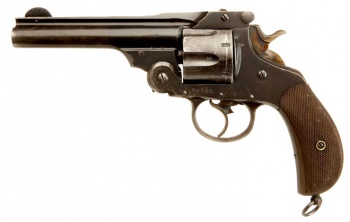
Smith & Wesson .44 Double Action (Eibar replica) - .455 Webley

Only appearance of the Smith & Wesson .44 Double Action next to the corpse of one of the Mexican soldiers.
Rast & Gasser M1898
During the film's climax, Ballantine (Dean Reed) is armed with a Rast-Gasser M1898 to defend himself against Mexican soldiers.
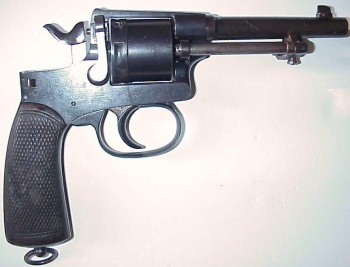
Rast & Gasser Modell 1898 - 8x27mm Gasser

Ballantine opens a box containing dynamite inside, having the idea of firing his Rast & Gasser M1898 to light the fuse and launch the dynamite towards the soldiers.
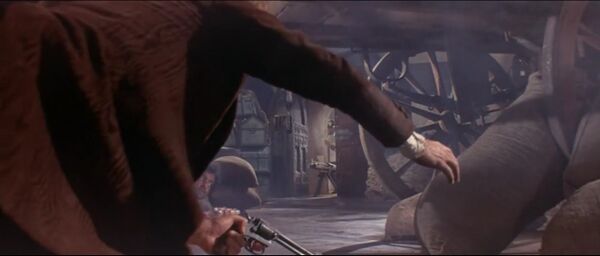
Ballantine throws the lit dynamite towards the soldiers who placed a Gatling gun in the room.

Ballantine aims his Rast & Gasser M1898 to try to hit
a fistful of dynamite and blow up the bridge so Sabata and the others can't reach it.

Ballantine realizes that Sabata made holes in the shipment containing the Mexican army's gold, causing everything to be lost along the way.

Ballantine tries to convince Sabata and Escudo that he is one of them, although he previously intended to abandon them and take an entire shipment of gold.
Rifles
Martini-Henry
When Ballantine's men and Escudo's revolutionaries confront each other, one of them is armed with a Martini-Henry.

Martini-Henry Mk. II (1877-1881) - .577-.450 caliber

One of Ballantine's men aims and fires his Martini-Henry rifle at Escudo and Gitano.

After expending your last shot, pull the lever on the Martini-Henry to insert a new cartridge.

One of Ballantine's men who survived the revolutionaries points his Martini-Henry at Manuel García.
Remington Model 1867 Rolling Block
At the beginning of the film, three bandits appear at the texas bounty hunters agency armed with Remington Rolling Block rifles to confront Sabata (Yul Brynner). The Rolling Block is also used by the Escudo's revolutionaries, although they are barely distinguishable.

Remington Model 1867 Rolling Block w/ 37.4" barrel - 45-70 Government

The leader of the three bandits faces Sabata with his Rolling Block in his hands.

The bandit leader aims and fires his Rolling Block at a decorative figure of a rooster to make it spin, so that when it stops, his men will shoot at Sabata.

The bandits leader inserts a cartridge into his Rolling Block after expending his only shot.

As expected, Sabata kills the three bandits who wanted him dead.
A close-up shot of one of the bandits' Remington Rolling Block.
Sabata's Harmonica Rifle
One of the most iconic weapons in the Sabata trilogy is the Harmonica rifle used by [[]], which may remind you of a Winchester Model 1866 "Yellow Boy" with the stock and barrel cut off (reminiscent of a Mare's Leg).
Although the Sabata rifle used by Yul Brynner is a prop made for the film and is therefore designed to use blanks cartridges, the harmonica guns existed in real life for a brief period of time. One of the most prominent designers of harmonica guns was Johnatan Browning (Father of Moses Browning), who created several models of this type of weapon, highlighting a rifle very similar to the one used by Sabata.

Sabata takes out the tiny harmonica magazine that he uses to try to intimidate the three bandits who came to kill him.

Sabata fires his harmonica rifle at the three bandits, this time using a longer harmonica magazine. After expending one shot from the magazine, Sabata has to pull the lever and push the harmonica magazine in order to fire again.

Sabata takes out a cigarette that he had put in the last space of the chamber of his harmonica magazine.

Sabata fires his
harmonica rifle during the ambush towards the Mexican army when they were transporting the supposed shipment of gold.

Sabata fires his rifle as Ballantine escapes with the carriage containing the real Mexican army's shipment of gold.
Springfield Model 1842
The Springfield Model 1842 is the service rifle of the Mexican army in the film,

Springfield Model 1842 w/ brass furniture (Palmetto Armory replica) - .69 Smoothbore

Colonel Skimmel grabs one of the Springfield Model 1842s that one of his assistants gives him.

Skimmel aims and fires his Springfield Model 1842 at one of the Mexicans he has captured.
Similar to a scene from the
Sergio Corbucci film,
Django (1966)
Skimmel fires all the Springfield Model 1842 rifles that his assistants pass him until he kills all the captured Mexicans.

Escudo is armed with a Springfield Model 1842 during the ambush he prepares with Sabata to ambush at the treasure of the Mexican army.
Machine Guns
M1865 Gatling Gun
At various points in the film, mainly during the climax, several Mexican soldiers are seen carrying and using a Gatling Gun against the Escudo's revolutionaries.
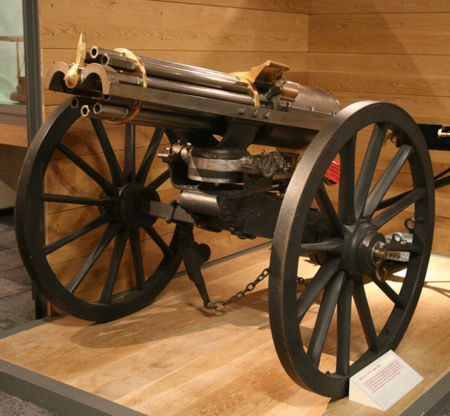
M1865 Gatling Gun - .50-70 Government/.58 Rimfire (RF)

A fake Mexican soldier fires the Gatling gun at the real Mexican soldiers, to make way for his group of revolutionaries.

A close-up shot of the Gatling Gun.

One of the soldiers carries a Gatling gun at the entrance to the Mexican army military base.

During the final battle at the military barracks, Mexican soldiers use several Gatling guns against Sabata and his group.



